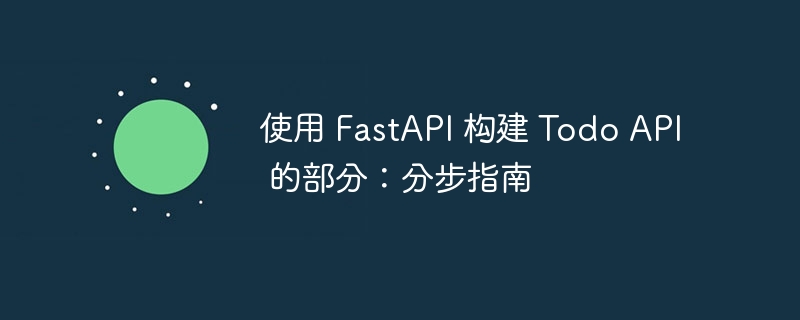使用 FastAPI 构建 Todo API 的部分:分步指南
来源:dev.to
时间:2024-09-09 15:45:57 414浏览 收藏
各位小伙伴们,大家好呀!看看今天我又给各位带来了什么文章?本文标题是《使用 FastAPI 构建 Todo API 的部分:分步指南》,很明显是关于文章的文章哈哈哈,其中内容主要会涉及到等等,如果能帮到你,觉得很不错的话,欢迎各位多多点评和分享!

使用 fastapi 构建 todo api:分步指南
代码可以在这里找到:github - jamesbmour/blog_tutorials:
一、简介
在上一篇文章中,我们介绍了fastapi并建立了基本的项目结构。现在,我们将更进一步,构建一个功能性的 todo api。在本教程结束时,您将拥有一个可以创建、读取、更新和删除待办事项的工作后端。
我们将涵盖的内容:
- 设计 todo 数据模型
- 实现crud操作
- 创建 api 端点
- 添加输入验证和错误处理
- 测试api
- 重构和组织代码
二.设计 todo 数据模型
为了管理待办事项,我们必须定义一个表示待办事项的数据模型。 fastapi 使用 pydantic 模型来验证和解析数据,因此我们将在这里利用它。
a. 定义 todo 模式
我们将使用 pydantic 创建两个模型:
- todocreate:用于创建或更新待办事项时的输入数据。
- todo:用于完整的待办事项,包括 id 和created_at 等字段。
from pydantic import basemodel
from typing import optional
from datetime import datetime
class todocreate(basemodel):
title: str
description: optional[str] = none
completed: bool = false
class todo(basemodel):
id: str
title: str
description: optional[str] = none
completed: bool
created_at: datetime
b. 解释字段
- id:每个待办事项的唯一标识符。
- 标题:待办事项的主要内容。
- 描述:其他详细信息(可选)。
- completed:待办事项的布尔状态(无论是否完成)。
- created_at:指示待办事项创建时间的时间戳。
三.为 todos 创建 crud 操作
crud 代表创建、读取、更新和删除——管理数据的四个基本操作。在本教程中,我们将使用内存数据库(一个简单的列表)来实现这些操作。
a. 设置内存数据库
我们将使用一个列表来存储我们的待办事项。为了简单起见,我们还将添加一些示例待办事项。
from uuid import uuid4
from datetime import datetime
todos = [
{
"id": str(uuid4()),
"title": "learn fastapi",
"description": "go through the official fastapi documentation and tutorials.",
"completed": false,
"created_at": datetime.now(),
},
{
"id": str(uuid4()),
"title": "build a todo api",
"description": "create a rest api for managing todo items using fastapi.",
"completed": false,
"created_at": datetime.now(),
},
{
"id": str(uuid4()),
"title": "write blog post",
"description": "draft a blog post about creating a todo api with fastapi.",
"completed": false,
"created_at": datetime.now(),
},
]
b. 实现辅助函数
我们将实现一个简单的辅助函数来通过 id 查找待办事项。
def get_todo_by_id(todo_id: str):
for todo in todos:
if todo["id"] == todo_id:
return todo
return none
四.实施 api 端点
a. 创建新的待办事项
post 端点允许用户创建新的待办事项。
@app.post("/todos/", response_model=todo)
def create_todo(todo: todocreate):
new_todo = todo(
id=str(uuid4()),
title=todo.title,
description=todo.description,
completed=todo.completed,
created_at=datetime.now()
)
todos.append(new_todo.dict())
return new_todo
b. 检索所有待办事项
get 端点从我们的内存数据库中检索所有待办事项。
@app.get("/todos/", response_model=list[todo])
def get_all_todos():
return todos
c. 检索单个待办事项
get 端点允许通过 id 检索单个待办事项。
@app.get("/todos/{todo_id}", response_model=todo)
def get_todo(todo_id: str):
todo = get_todo_by_id(todo_id)
if not todo:
raise httpexception(status_code=404, detail="todo not found")
return todo
d. 更新待办事项
put 端点允许用户更新现有的待办事项。
@app.put("/todos/{todo_id}", response_model=todo)
def update_todo(todo_id: str, todo_data: todocreate):
todo = get_todo_by_id(todo_id)
if not todo:
raise httpexception(status_code=404, detail="todo not found")
todo["title"] = todo_data.title
todo["description"] = todo_data.description
todo["completed"] = todo_data.completed
return todo(**todo)
e. 删除待办事项
delete 端点允许用户通过 id 删除待办事项。
@app.delete("/todos/{todo_id}")
def delete_todo(todo_id: str):
todo = get_todo_by_id(todo_id)
if not todo:
raise httpexception(status_code=404, detail="todo not found")
todos.remove(todo)
return {"detail": "todo deleted successfully"}
v. 添加输入验证和错误处理
a. 使用 pydantic 进行输入验证
fastapi 自动根据我们定义的 pydantic 模型验证输入数据。这确保数据在处理之前符合我们预期的模式。
b. 自定义错误处理
我们可以通过添加异常处理程序来自定义错误响应。
@app.exception_handler(HTTPException)
def http_exception_handler(request, exc: HTTPException):
return JSONResponse(
status_code=exc.status_code,
content={"detail": exc.detail},
)
六.测试 api
fastapi 附带交互式 swagger ui 文档,可以轻松测试您的 api 端点。只需运行应用程序并在浏览器中导航至 /docs 即可。
测试实例
- 创建待办事项:通过创建新的待办事项来测试 post 端点。
- 检索待办事项:使用 get 端点获取所有待办事项或按 id 获取特定待办事项。
- 更新和删除:测试 put 和 delete 端点以更新或删除待办事项。
七.重构和组织代码
随着应用程序的增长,保持代码的组织性至关重要。这里有一些提示:
a. 将模型移动到单独的文件
您可以将 pydantic 模型移动到 models.py 文件中,以保持主应用程序文件干净。
b. 为 todo 端点创建路由器
考虑为与待办事项相关的端点创建一个单独的路由器,特别是随着您的 api 的增长。
八.下一步
在下一篇文章中,我们将把一个真实的数据库(如 sqlite 或 postgresql)集成到我们的 fastapi 应用程序中。我们还将研究用户身份验证和更高级的功能。
建议的改进:
- 为 get 端点添加过滤和分页。
- 实现用户身份验证来管理个人待办事项。
九.结论
在本教程中,我们使用 fastapi 构建了一个简单的 todo api。我们首先设计一个数据模型,实现 crud 操作,并创建端点来管理待办事项。我们还涉及输入验证、错误处理和测试。有了这个基础,您可以进一步扩展 api 或将其与前端集成以创建成熟的应用程序。
如果你想支持我的写作或给我买啤酒:
https://buymeacoffee.com/bmours
本篇关于《使用 FastAPI 构建 Todo API 的部分:分步指南》的介绍就到此结束啦,但是学无止境,想要了解学习更多关于文章的相关知识,请关注golang学习网公众号!
-
501 收藏
-
501 收藏
-
501 收藏
-
501 收藏
-
501 收藏
-
106 收藏
-
242 收藏
-
250 收藏
-
197 收藏
-
336 收藏
-
227 收藏
-
363 收藏
-
351 收藏
-
214 收藏
-
174 收藏
-
145 收藏
-
200 收藏
-

- 前端进阶之JavaScript设计模式
- 设计模式是开发人员在软件开发过程中面临一般问题时的解决方案,代表了最佳的实践。本课程的主打内容包括JS常见设计模式以及具体应用场景,打造一站式知识长龙服务,适合有JS基础的同学学习。
- 立即学习 543次学习
-

- GO语言核心编程课程
- 本课程采用真实案例,全面具体可落地,从理论到实践,一步一步将GO核心编程技术、编程思想、底层实现融会贯通,使学习者贴近时代脉搏,做IT互联网时代的弄潮儿。
- 立即学习 516次学习
-

- 简单聊聊mysql8与网络通信
- 如有问题加微信:Le-studyg;在课程中,我们将首先介绍MySQL8的新特性,包括性能优化、安全增强、新数据类型等,帮助学生快速熟悉MySQL8的最新功能。接着,我们将深入解析MySQL的网络通信机制,包括协议、连接管理、数据传输等,让
- 立即学习 500次学习
-

- JavaScript正则表达式基础与实战
- 在任何一门编程语言中,正则表达式,都是一项重要的知识,它提供了高效的字符串匹配与捕获机制,可以极大的简化程序设计。
- 立即学习 487次学习
-

- 从零制作响应式网站—Grid布局
- 本系列教程将展示从零制作一个假想的网络科技公司官网,分为导航,轮播,关于我们,成功案例,服务流程,团队介绍,数据部分,公司动态,底部信息等内容区块。网站整体采用CSSGrid布局,支持响应式,有流畅过渡和展现动画。
- 立即学习 485次学习
